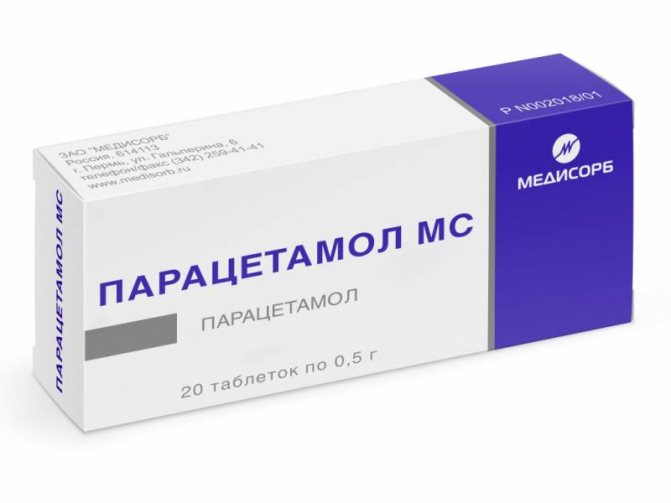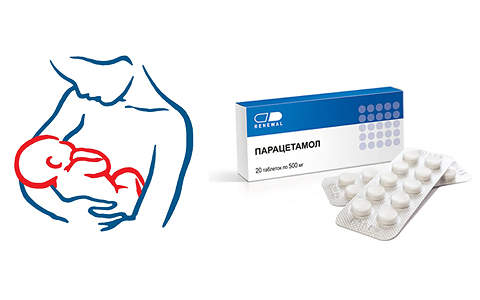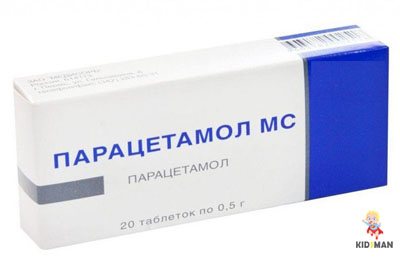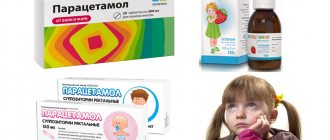Paracetamol during breastfeeding for headaches instructions for use
Paracetamol for headaches during breastfeeding is rarely prescribed, since the medication tends to accumulate in small quantities in breast milk. However, if we consider this drug along with other drugs with an analgesic effect, then paracetamol is one of the safest medications with an analgesic effect during this period. Let's consider the dosage and rules for taking the drug while breastfeeding.
Instructions for use
Can a nursing mother take Paracetamol if she is feeling unwell? The right time to use the drug is immediately after feeding the baby. 40 minutes after using Paracetamol, the highest concentration of the active substance in the blood is achieved. Therefore, there is no need to feed the baby during this period.
An interval of 3-4 hours after taking Paracetamol is most suitable for infants to eat. After all, by this time the drug will be eliminated from the body and will become less toxic for the baby.
Taking the medicine begins after using time-tested folk remedies. You can use a warm drink in the form of tea with jam or honey, gargling with eucalyptus infusion. If all these methods do not help, then the woman should consult a doctor for proper treatment.
How much Paracetamol can a nursing mother take? According to generally accepted instructions, Paracetamol during lactation is taken as follows: 1 tablet three times a day as needed, but usually for 2-3 days.
However, many experts do not recommend drinking the drug for minor ailments, nasal congestion or a slight increase in temperature. Doctors do not recommend reducing fever at levels below 38.5 degrees. Indeed, in this case, high temperatures indicate a protective reaction - the body has directed all its forces to fight infection and inflammation.

Release form and composition
There are several forms of release of this drug, so each patient can choose the best option for himself. Let's look at them:
- Tablets of 250 and 500 mg;
- Syrup;
- Capsules;
- Suspension;
- Solution;
- Granules for suspension;
- Rectal suppositories.
Note! Suppositories, suspensions and syrups are intended for the treatment of children under twelve years of age. During the period of guarding, for headaches and other pathologies, it is preferable to use tablets or capsules.
In addition to the active ingredient, the tablets contain additional components: stearic acid, calcium, starch, gelatin, lactose, Primogel, povidone.
pharmachologic effect
When using paracetamol for headaches, a nursing mother should take into account that the medication is symptomatic, so first of all it is necessary to identify the cause of the symptom. Suppressing pain, including headaches, can lead to the development of more severe pathologies.
The therapeutic effect of the drug has been proven by a large number of studies. Meta-analyses state that the drug has a pronounced effect on pain syndromes after surgery, dental pain and headaches. Compared to other analgesics, the effectiveness of paracetamol is almost twice as high. The fact is that this medication has a powerful effect on pain centers, as a result of which the threshold of sensitivity to pain of various types increases. Another advantage of the drug is the fact that it does not affect the mucous membranes of the gastrointestinal tract and is completely eliminated from the body within six hours.
Is paracetamol allowed for breastfeeding?
Paracetamol relieves pain by gently suppressing inflammatory processes. Compared to other analgesics, it is less toxic, and moderate use does not harm the baby.
The drug has an intensive effect on the nerve centers responsible for thermoregulation, gradually reducing the temperature. It acts as an excellent antipyretic, anti-inflammatory, and analgesic agent. It is quickly absorbed by the body and quickly relieves acute pain. The medicine is universal: you don’t need to buy several drugs with different effects if you have Paracetamol in your medicine cabinet.
Like any medicine, in case of overdose and non-compliance with the rules for use, it accumulates in the body and becomes toxic . Paracetamol is not contraindicated for breastfeeding and doctors calmly prescribe it to nursing mothers.
Description and properties of the drug
Paracetamol is a synthetic substance that has a powerful antipyretic and analgesic effect. In addition, the drug has a weak anti-inflammatory effect, which is also not neglected when choosing therapy.
It should also be said that this medicine has been one of the most popular antipyretics for many years. This fact is due to a combination of good therapeutic effects and the relative safety of the drug.

Paracetamol analogues during breastfeeding
When breastfeeding, you can use medications whose active ingredient is paracetamol. It is permissible to use different forms, with local action if possible. The most common medications:
- panadol;
- cefekon;
- rapidol;
- calpol;
- perfalgan;
- efferalgan.
Attention! During breastfeeding, combination drugs should not be used. For example, ibuclin or milistane can cause more side effects and are therefore not recommended for breastfeeding.
Paracetamol is considered one of the least toxic substances. Included in many medicines. Suitable for single use and short course (3 days). Medicines based on it are approved for the treatment of women during breastfeeding. It is necessary to strictly follow the specialist’s instructions and not increase the permissible dosage so that the baby does not receive a harmful substance along with the milk.
Indications for use
During lactation, the drug can be used to eliminate the following pathological conditions:
- Body temperature is more than 38 degrees.
- Hyperthermic syndrome caused by the presence of an inflammatory process in the body.
- Moderate toothache.
- Headaches of varying severity, including migraines.
Note! A breastfeeding mother should not ignore health problems as it may affect her baby. Therefore, if any of the listed symptoms appear, a woman should consult a doctor.
When to take
The use of paracetamol during breastfeeding is justified for the following ailments:
- body temperature above 38.5 ° C;
- aching toothache;
- mild migraine;
- joint pain;
- premenstrual discomfort;
- neuralgia;
- myalgia.
Some women experience stagnation of milk in the breast. This occurs in one of the lobes of the mammary glands. When the disease occurs, a woman feels unwell, similar to the onset of a cold. The temperature rises, the body aches, the chest hurts with stagnant milk.
In this condition, Paracetamol and its analogue Ibuprofen are prescribed. The drugs will relieve pain and allow you to properly eliminate congestion in the chest, avoiding serious complications.
Before taking the drug for headache pain, you should go for a walk or sleep. Perhaps the cause of the malaise was simple overwork.
For tooth pain, taking the drug is justified only before a visit to the dental clinic. Carious teeth have a detrimental effect on the body of a nursing mother, representing a source of infection in the oral cavity. This is a greater health threat.
Many women are afraid to take medications during lactation. But the lack of proper treatment entails a greater risk to the health of the mother and child.
Attention! If treated incorrectly or ignored, lactostasis turns into mastitis.
Some people stop breastfeeding while taking the drug. But a sudden separation from the breast is much more dangerous for the baby’s health than a small dose of paracetamol in mother’s milk.
Directions for use and dosage during lactation
When using paracetamol for headaches while breastfeeding, you must strictly adhere to the permissible dosage. Most experts believe that during lactation the drug should be taken according to the standard regimen for the treatment of adult patients. The effective dosage in this case is 500 milligrams at a time. The tablet is taken an hour after a meal with plenty of water.
The product can be taken up to four times a day at intervals of five hours, with a maximum dose of four grams per day. The duration of headache treatment should not exceed five days.
Dosage during breastfeeding
Paracetamol, despite its relative harmlessness, cannot be taken whenever you want. In order not to harm the baby and yourself during breastfeeding, it is important to adhere to a certain algorithm:
- It is unacceptable to take Paracetamol for headache attacks for longer than 3 days. If the condition does not improve, you should seek medical help.
- Migraine attacks during breastfeeding can be relieved with cold compresses, rest, walking, and strong, sweetened warm tea.
- Toothache cannot be tolerated and it is pointless to suppress the painful pulsating sensations with Paracetamol. As soon as possible, mommy needs to see a dentist.
- If you have a cold, you can gargle with soda solution or chamomile infusion. Rinse your nose with saline solutions, use compresses, drink vitamins (about vitamins for breastfeeding).
It is ideal to take the tablets after feeding the baby. Feeding should be calculated so that the mother eats 1-2 hours before. The presence of food in the stomach cavity delays the absorption of Paracetamol. As an alternative, it is advisable to use rectal suppositories.
The concentration of the active substances of Paracetamol reaches its maximum limit in milk half an hour after administration, and it is not advisable to feed a newborn at this time. After 3-4 hours, almost all Paracetamol is eliminated from the body naturally (by the liver and kidneys).
Paracetamol is taken by nursing women according to a certain scheme:
- For 2-3 days they drink a whole tablet of 500 g - no more than 3 times a day;
- You should not take the tablets with coffee drinks or tea - they will increase the risk of side effects;
- the interval between doses should be at least 4 hours;
- It is forbidden to drink alcohol during treatment with Paracetamol. But caring and reasonable mothers do not drink alcohol while breastfeeding;
- the temperature rises due to the body’s protective reaction when an infection or virus enters it. You shouldn’t knock it down when the thermometer is less than 38 C.
If you have a slight headache or aching joints, there is no need to rush to the pharmacy. These symptoms are easily suppressed with herbs, ointments, and rubbing essential oils into the temples. When breastfeeding, medications are an emergency aid when other methods are powerless.
Side effects and impact on the child
The instructions for use of the medicine clearly indicate that it should be taken with caution during lactation. However, most doctors recommend taking paracetamol during this period to eliminate various pain syndromes, including headaches.
Regarding the effect of the drug on the baby’s body and the accumulation of the substance in breast milk, clinical studies have proven that the volume of the active component that can enter the baby through breast milk is less than the usual pediatric dose of the drug.
Overdose
An overdose can develop in a patient only if the permissible dosage is exceeded. So, from thirty tablets a day, the patient will experience irreversible liver damage, and when taking 40 tablets, death is possible. Therefore, you need to carefully monitor the dosage of the drug and do not forget that this substance is contained in many medications.
Paracetamol during breastfeeding is an effective remedy for fever and treatment of various types of pain syndromes. However, despite the relative safety of the drug, a nursing mother should always consult a doctor before taking the drug.
What is this medicine and how does it work?
Paracetamol is a drug that has analgesic and antipyretic effects. It belongs to the category of non-narcotic, therefore it is allowed for use in adults and children. In addition, it can reduce existing inflammation in the body.
Paracetamol is used quite widely during breastfeeding, because... Among its undoubted advantages is the fact that it is very quickly absorbed, acts and is excreted from the body, without getting into milk.

This drug is usually prescribed in a number of cases, which include:
- high temperature;
- headache;
- pain in muscles and joints;
- toothache.











